Grumman J2F Duck: can you retract the gear on the ground?
Fri Mar 01, 2013 11:12 am
The reason for this odd question: I'm writing a short article on the recent discovery of a crashed USCG Duck on Greenland. The airplane was involved in the rescue of crashed B-17 crewmen when it was lost with two crew and a passenger from the B-17 crew.
One account of the first of two flights to the B-17 crash site says the pilot landed the Duck with the gear down, on a smooth-looking snow-covered area free of crevasses. Yet the pilot's own written account of his subsequent takeoff says he made it gear up, using the pontoon as a huge ski.
Would it have been possible for the pilot to retract the gear -after- landing on snow with it down? I'm guessing he landed with the gear up.
As long as I'm in a questioning mood, the company that found the Duck (North South Polar, Inc.--Lou Sapienza of "Glacier Girl" fame) claims that the J2F's first landing on the icecap in November 1942 was "the first time an airplane had ever landed safely on the Greenland icecap." Could this be true? I should think some Arctic explorer would have done it before '42.
One account of the first of two flights to the B-17 crash site says the pilot landed the Duck with the gear down, on a smooth-looking snow-covered area free of crevasses. Yet the pilot's own written account of his subsequent takeoff says he made it gear up, using the pontoon as a huge ski.
Would it have been possible for the pilot to retract the gear -after- landing on snow with it down? I'm guessing he landed with the gear up.
As long as I'm in a questioning mood, the company that found the Duck (North South Polar, Inc.--Lou Sapienza of "Glacier Girl" fame) claims that the J2F's first landing on the icecap in November 1942 was "the first time an airplane had ever landed safely on the Greenland icecap." Could this be true? I should think some Arctic explorer would have done it before '42.
Re: Grumman J2F Duck: can you retract the gear on the ground
Fri Mar 01, 2013 1:09 pm
Unless I am mistaken, J2F gear is like Wildcat gear, including sharing some common components. It is a manually operated gear box. I am not sure about the locking situation once in down position, but as long as there wasn't a load on the gear, I think it could be retracted. This was so the aircraft could be taxied down a seaplane ramp on the main gear into the water, then taken off as a seaplane. If they had landed on a bumpy-ice covered area, taking off using the float shoe could have been a good call for directional control and preventing tearing out the main gear on some obstruction. Interesting idea.
Re: Grumman J2F Duck: can you retract the gear on the ground
Fri Mar 01, 2013 1:17 pm
Sitting on the snow and armed with a shovel, you could eventually have the airplane sitting on it's float with the wheels dangling in your two newly dug holes, leaving them free to be retracted as if it were in the water. Landing on those narrow little wheels on snow though probably wouldn't have worked real well. I expect he landed and took off with the gear up.
Re: Grumman J2F Duck: can you retract the gear on the ground
Fri Mar 01, 2013 3:32 pm
I've been involved with that project since it started in 2008. Yes, Pritchard landed the Duck with the wheels down. Yes, they retracted the wheels up for takeoff and then turned the plane around to takeoff the same direction he landed...downhill. He was lucky he didn't flip the plane. He was also lucky in walking over to the B-17 (call sign PN9E) in that he didn't use the snow shoes or rope that COL Bernt Balchen dropped to him out of his C-54 flying overhead. Pritchard crossed over numerous snow-covered crevasses to get to the PN9E. A total of 3 people fell into the crevasses....one recovered alive, two didn't make it and are still up there.
As far as we know, he was the first to land directly on the ice cap in that manor. Shortly before that though, a PBY, piloted by LT Dick Parunak with COL Bernt Balchen along, did land on a "lake" that was on the ice cap. This was for the rescue of another B-17....My Gal Sal I'm thinking?? This is the story of the "disappearing lake"....it supposedly drained sometime after they tookoff. You can look around on the internet or here and find the pick of another PBY sitting on the ice cap in April of '43. They were involved in the PN9E rescue too. COL Balchen took those pics.
As far as we know, he was the first to land directly on the ice cap in that manor. Shortly before that though, a PBY, piloted by LT Dick Parunak with COL Bernt Balchen along, did land on a "lake" that was on the ice cap. This was for the rescue of another B-17....My Gal Sal I'm thinking?? This is the story of the "disappearing lake"....it supposedly drained sometime after they tookoff. You can look around on the internet or here and find the pick of another PBY sitting on the ice cap in April of '43. They were involved in the PN9E rescue too. COL Balchen took those pics.
Re: Grumman J2F Duck: can you retract the gear on the ground
Sat Mar 02, 2013 10:04 am
Forgotten Field wrote:Unless I am mistaken, J2F gear is like Wildcat gear, including sharing some common components. It is a manually operated gear box. I am not sure about the locking situation once in down position, but as long as there wasn't a load on the gear, I think it could be retracted. This was so the aircraft could be taxied down a seaplane ramp on the main gear into the water, then taken off as a seaplane. If they had landed on a bumpy-ice covered area, taking off using the float shoe could have been a good call for directional control and preventing tearing out the main gear on some obstruction. Interesting idea.
I'm betting that the landing gear systems on the J2F Duck and the G-21A/JRF Goose had more in common with each other than they did with the F4F Wildcat. The Duck and the Goose used essentially the same balance floats (just mounted differently) and also shared common if not actually identical lower hull frames too (from the main step forward.) In fact, the blueprints / engineering drawings for the Goose lower hull frames directly reference previously existing drawings for the Duck. The landing gear on the Duck and the Goose both retract and store essentially vertical against the somewhat "slab" sides of their respective airframes, whereas the gear on the Wildcat tucks under / inward in order to align with the more round / circular cross section of its fuselage at that point. Also, whereas the Goose uses torque tubes to drive the gear boxes which pivot the gear, I believe that the Wildcat uses chain drives. Don't know about the Duck in particular, but whichever drive mechanism it has or uses will tell you which other Grumman product it most closely resembles in terms of landing gear.
The gear in this photo looks very "Goose"-like - including the little half doors that seal against the bottom portion of the tire when it is retracted:
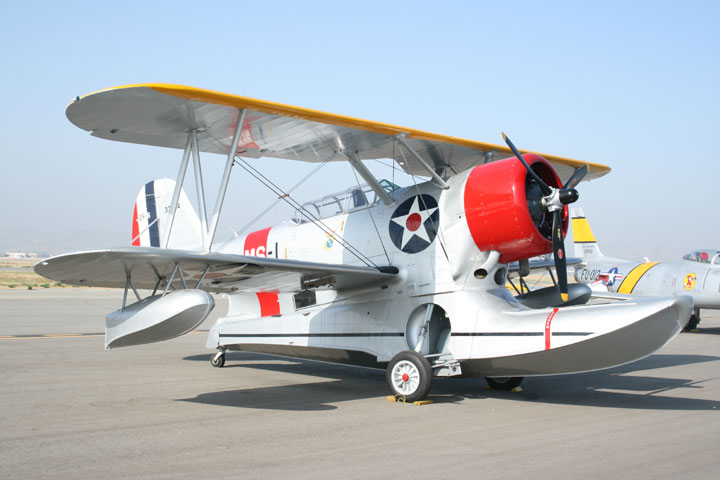
*The wheels on this Duck also appear to be the same Goodyear p/n 9530113 "original equipment" 9.50-16 wheels from a G-73 Mallard that were authorized to be used on a Goose per Grumman G-21 Service Bulletin No. 23 (dated 11-8-1953.)
All that being said, it probably makes no difference in terms of answering the original question here. Based on my knowledge and experience with Goose landing gear, I'm gonna agree that it could be done (retract the gear on the ground) but with the same caveat expressed earlier - it'd have to be "unloaded" first to be able to release the down locks.
A Goose is incredibly easy to "jack" - all you need is two vee-shaped "saw horse" cradles. A couple of people can pick up the tail and slide the first one under the primary step just aft of the main wheels (which is VERY close to the CG) and then pull down on the tail and pivot the nose up high enough to slide the second one in under the front hull, thus picking the main wheels up completely off the ground. No hydraulic jacks or cranes required.
Of course, that procedure wouldn't work on snow and ice, but Mr. Jones' idea of mounding snow under the float and digging holes around the main gear to unload them would seem to be sufficiently effective to accomplish the exact same thing.
Kudos to you Mr. Jones

Re: Grumman J2F Duck: can you retract the gear on the ground
Sat Mar 02, 2013 11:04 am
Thanks, but I can't really take credit for the idea. I can tell you however that digging a hole in a frozen, gravel runway in the wintertime in order to change a tire is a heartbreakingly difficult task (that ground is HARD!) But it pales in comparison to placating a very upset airport manager who shows up halfway through said tire change and discovers that you have dug a hole in the geographical center of his runway. I mean, it's not like we weren't gonna fill it back in afterwards!


Re: Grumman J2F Duck: can you retract the gear on the ground
Sat Mar 02, 2013 12:10 pm
For you history buffs....this is an interesting read. It is on the Irving, TX library site. It is about then LT Harry Spencer, the co-pilot on the B-17 (PN9E) that crashed. He is the one who helped turn Pritchard's Duck around on the first landing and one of the three men who fell into a hidden crevasse. He luckily survived his fall and was pulled out by some parachutes tied toegther. There are a few errors in the artcile but it is a good one with pictures. You have to click thru the pages by the links at the bottom. One of the pictures is used as the cover for the upcoming book. I have an audio interview he did before he passed. Mr. Spencer passed in the early 2000's.
http://www.cityofirving.org/library/arc ... er-p01.asp
http://www.cityofirving.org/library/arc ... er-p01.asp
Re: Grumman J2F Duck: can you retract the gear on the ground
Sun Mar 03, 2013 7:46 pm
Here are some pages from a J2F-4 maintenance manual and one cockpit picture from a J2F-5 flight manual concerning the landing gear operation.It appears to say that the gear could be retracted on the ground if the ratchet release lever (item 7 in the cockpit picture) is unlocked.However,supporting the weight of the airplane on partially retracted gear is liable to shear one or more of the three bolts that connect each main gear upper oleo strut to the retracting mechanism.I'm not at all sure that this is the case,though because under "Wheel Lock" on the 3rd page of the text,it's stated that the spring counterbalance will prevent all possibility of the wheels retracting during take-off and landing.Whether that means that the rachet release will trump the counterbalance like a gear retraction over-ride in a DC-7 or not is unclear.I'll have to ask Brent Conner who flies Erickson's Duck the next time that I see him.Maybe,one of our experts can tell from the info below.
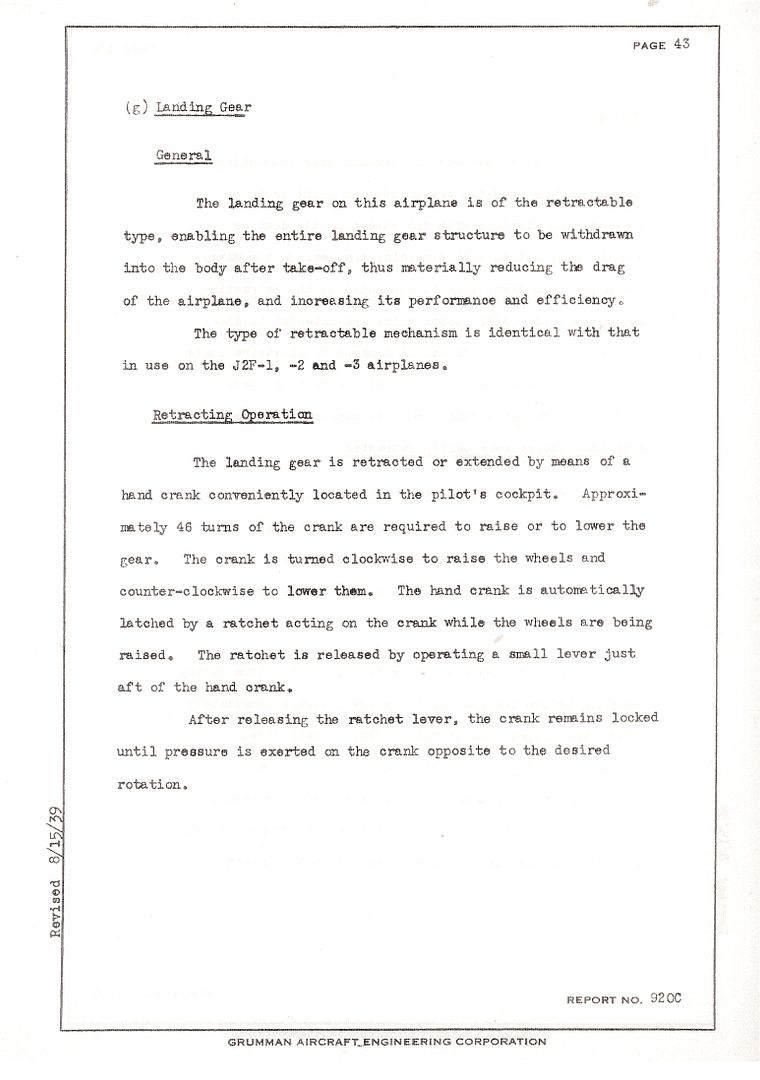


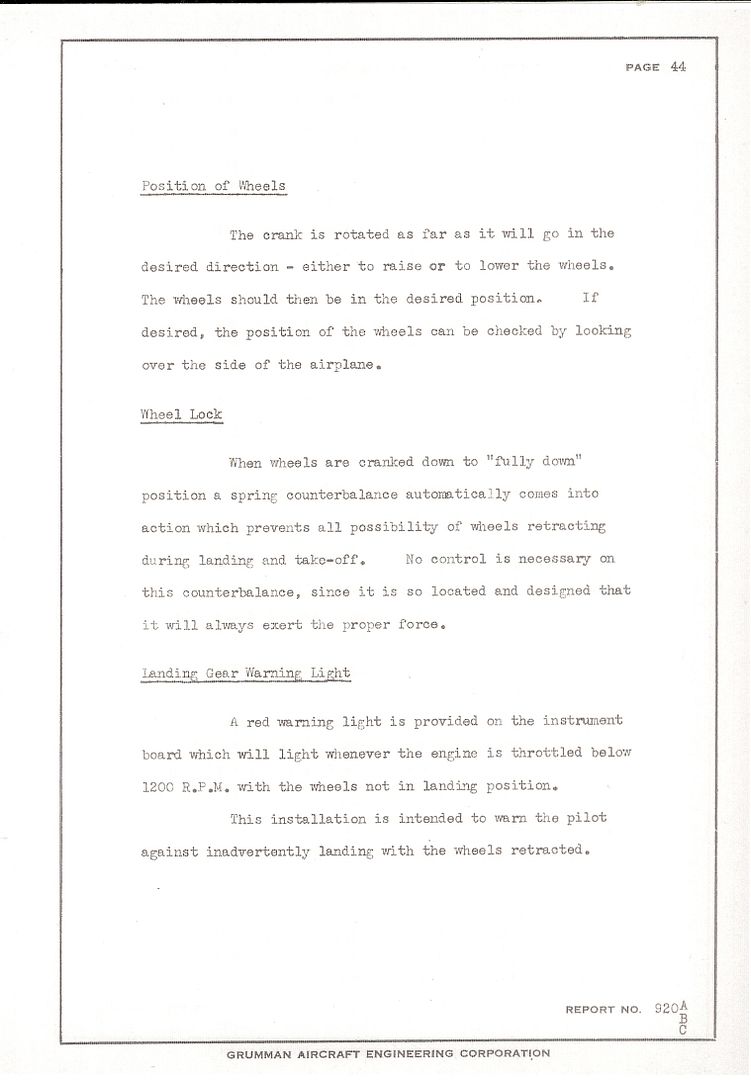
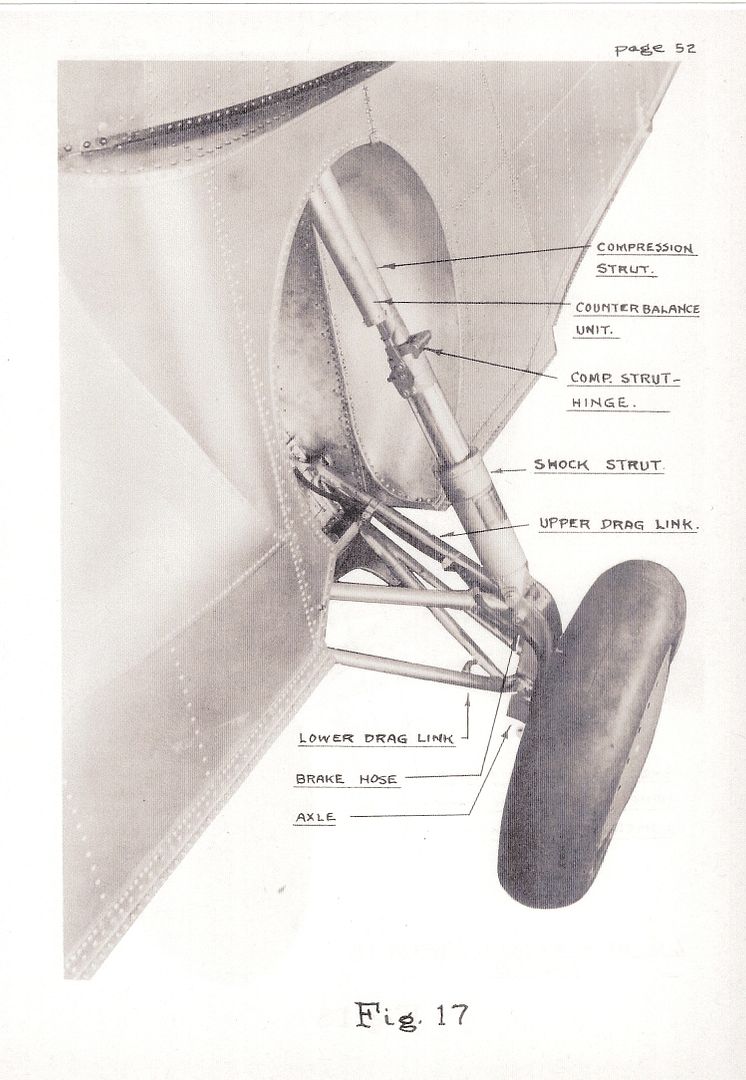
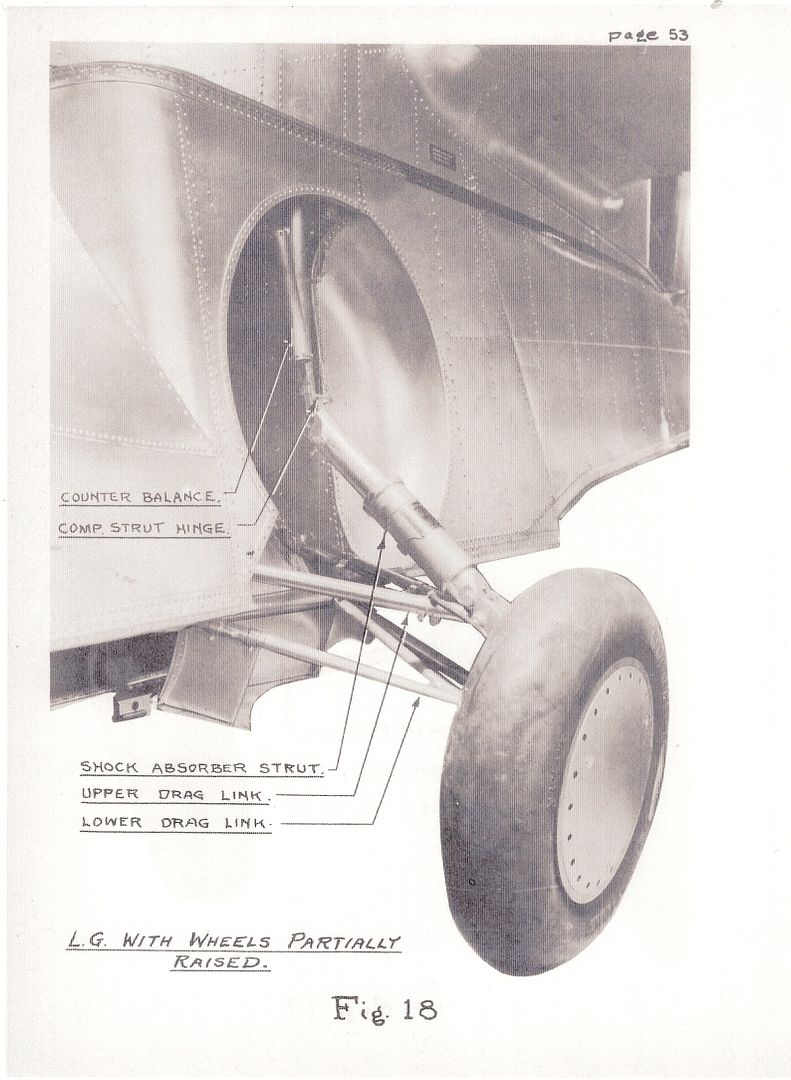
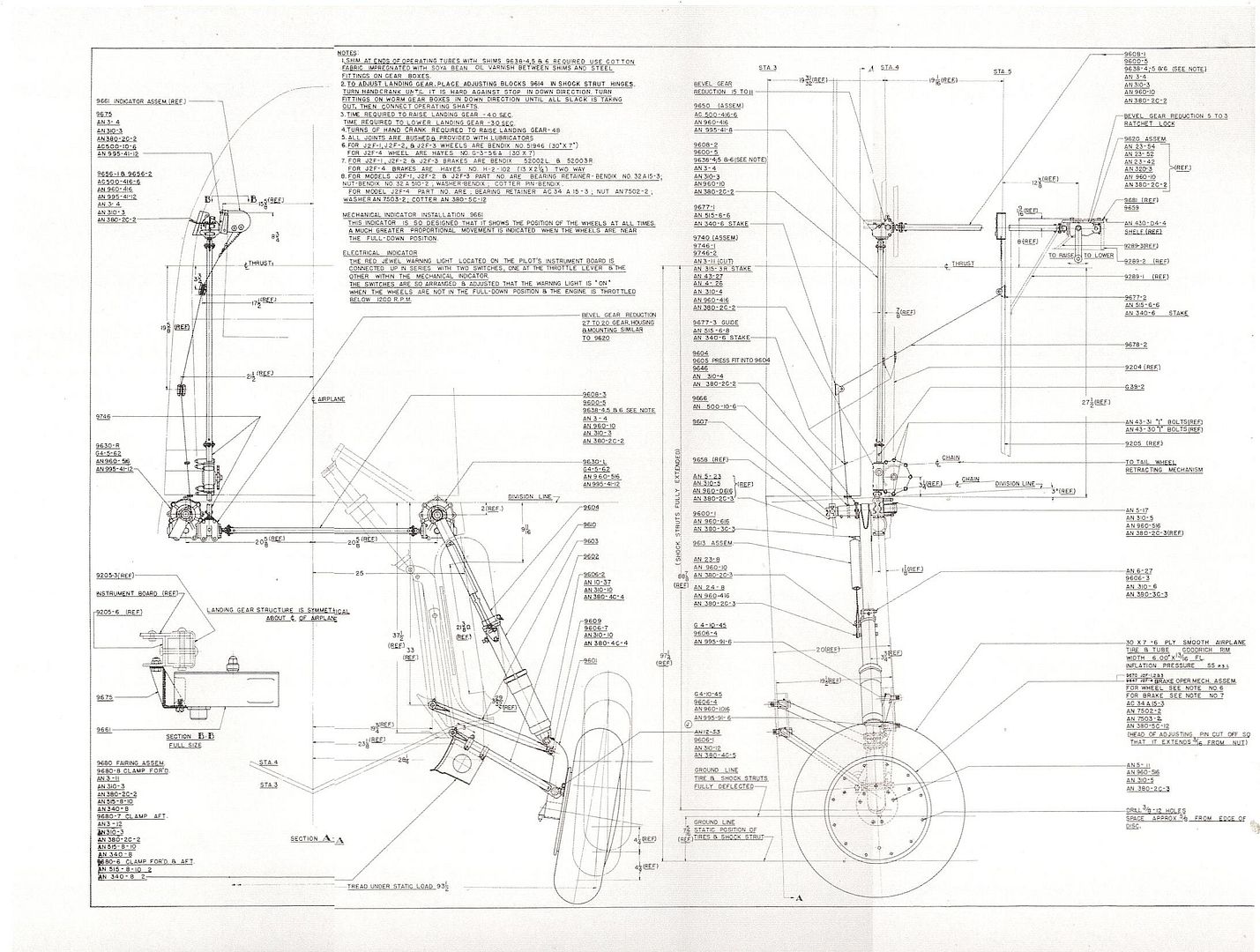
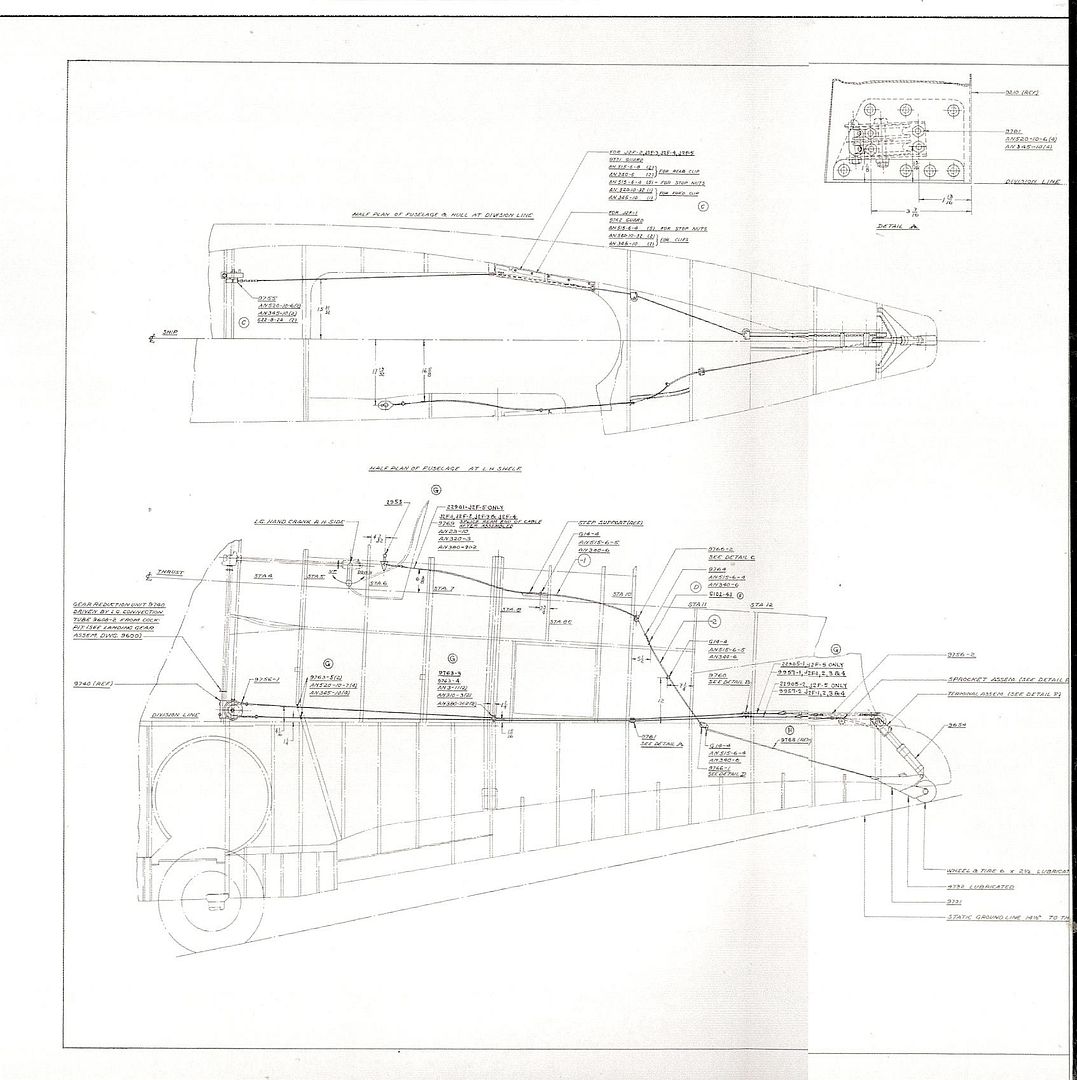










Re: Grumman J2F Duck: can you retract the gear on the ground
Sun Mar 03, 2013 8:02 pm
It's a similar deal as with the Goose except that the shear bolts are Grumman p/n 12646. According to their drawing, they aren't all that "special" as Grumman seems to have claimed for the ones in the Duck - the 12646 bolts are just cut down standard AN5-12 bolts (with a 1/2 inch head) that have new 1/4-28 NF threads cut (and that are subsequently re-heat treated to 125,000 psi.)
The shear bolts are there to prevent damage to the rest of the retraction system should a pilot inadvertently attempt to extend the gear in water that is too shallow. If the gear hits the bottom before it is fully extended, the bolts are supposed to shear instead of trying to pick up the whole airplane out of the water. The system is not strong enough to do that and might be damaged.
The shear bolts are there to prevent damage to the rest of the retraction system should a pilot inadvertently attempt to extend the gear in water that is too shallow. If the gear hits the bottom before it is fully extended, the bolts are supposed to shear instead of trying to pick up the whole airplane out of the water. The system is not strong enough to do that and might be damaged.
Re: Grumman J2F Duck: can you retract the gear on the ground
Sun Mar 03, 2013 8:27 pm
Here is a what I think is a great tutorial on the Duck. Kermit Weeks posted this up in December. He is wearing a head-cam or as he calls it a Kermie-Cam. He goes thru his walkaround, pre-start, start, TO (including raising the gear), water landing/TO and RTB. He does a pretty good job talking about his Duck and a few mods they did. You get a great perspective and view of everything. He also did this for at least a couple of his other planes.
Part 1
http://www.youtube.com/watch?v=nZMzzM7DlRg
Part 2
http://www.youtube.com/watch?v=0NnhpIfOCrI
Part 3
http://www.youtube.com/watch?v=fCFhxiUcsTw
Part 1
http://www.youtube.com/watch?v=nZMzzM7DlRg
Part 2
http://www.youtube.com/watch?v=0NnhpIfOCrI
Part 3
http://www.youtube.com/watch?v=fCFhxiUcsTw